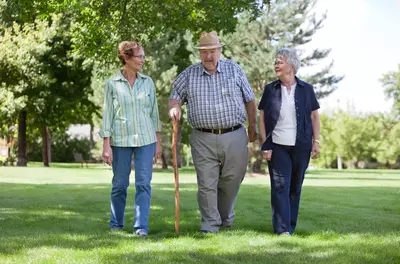Parkinson's Disease

What Lifestyle Changes Are Recommended for Parkinson’s Disease?
 While there is no magic diet or exercise program that will cure Parkinson’s disease (PD), there are many ways you can improve your quality of life and manage symptoms with simple lifestyle changes.
While there is no magic diet or exercise program that will cure Parkinson’s disease (PD), there are many ways you can improve your quality of life and manage symptoms with simple lifestyle changes.
Parkinson’s shows up differently for everyone, so there is no one-size-fits-all approach to these lifestyle changes. Some patients may have significant motor symptoms, while others experience more cognitive and neuropsychiatric symptoms. One person may lose their sense of smell but have manageable tremors, while another can smell and taste as usual but have difficulty lifting a spoon to their mouth.
So while the overall aim for everyone is to make healthy choices, how you adjust your life to meet the challenges presented by PD will be unique to you.
Healthy eating
 Eating may become more challenging as your symptoms progress, but nourishing yourself adequately is deeply important in maintaining strength, regulating sleep and mood, and enabling your body to function to the best of its ability. In general, you should try to eat whole foods that are primarily plant-based: lots of fruits and veggies of all colors, whole grains, beans and legumes. Typically, food that is good for the heart is good for the brain.
Eating may become more challenging as your symptoms progress, but nourishing yourself adequately is deeply important in maintaining strength, regulating sleep and mood, and enabling your body to function to the best of its ability. In general, you should try to eat whole foods that are primarily plant-based: lots of fruits and veggies of all colors, whole grains, beans and legumes. Typically, food that is good for the heart is good for the brain.
Two common issues that arise in people with Parkinson’s are malnutrition and constipation. Malnutrition, which occurs in up to 25% of people living with PD, may arise for various reasons, including a lack of appetite or nausea from medications, or motor symptoms that make preparing and eating food difficult. A loss of taste and smell is quite common, which can also impact appetite and the enjoyment you get from your food.
Constipation can be caused by medications, dehydration, and the disease itself. The slowing of the bowels can contribute to a feeling of uncomfortable fullness or anxiety about eating, which may lead to avoiding meals.
Because of these issues, eating a healthy, nourishing diet will likely become a priority in your life. Expert recommendations include:
- Drink at least 2 quarts of water each day. Staying hydrated can stave off constipation and weakness, as well as mitigate the dehydration that commonly occurs with some medications. But it can be hard to get the amount of fluids you need because of urinary frequency and urgency problems. One easy way to ensure you are getting enough water is to fill up two quart-sized bottles in the morning and put them out in a place where you will be regularly reminded to drink. Your job is to make sure those bottles are empty before dinner! Limit fluid intake after dinner.
- Eat high-fiber foods to keep your bowels moving. Beans and lentils, nuts, fruits and vegetables, and whole grains are good examples of foods high in fiber. It is important to take in adequate fluid when increasing fiber, to avoid painful cramping and flatus.
- Try a Mediterranean diet, which research indicates may do two important things: help regulate your gut’s microbiome and decrease risk of dementia. A Mediterranean diet generally includes whole, fresh foods: beans and legumes, fatty fish, healthy oils, and lots of high-fiber fruits and vegetables.
- Focus on antioxidants. According to neurologist Blas Bloem, MD, PhD, very early research in animals indicates that a diet high in antioxidants may slow the progression of Parkinson’s. Even if the research in this area is weak, antioxidant-rich foods are excellent for general health, so load up on berries and pecans - and add some dark chocolate, too (but not in the evening, as it may influence the quality of your sleep).
- Spread protein consumption throughout the day. Research indicates that protein may interfere with some Parkinson’s medications, including levodopa. But protein consumption is an important part of a balanced diet. Experts recommend avoiding a high-protein meal right before taking your medication - you may benefit from taking your medication 30-60 minutes before you eat. Check with your healthcare provider to get specific recommendations for you.
Additional Tips
If a lack of taste or smell is affecting your interest in eating, experiment with adding spices and fresh herbs to your food, especially ones you may not have tried before.
Many people with PD find that a Vitamin D supplement can be helpful, as it is difficult to get enough Vitamin D from diet alone. Check with your healthcare provider to see if that is a good choice for you.

Sample Mediterranean Menu
Breakfast
- Whole grain bread (toasted) with almond butter
- Apple slices
- Goat cheese
Lunch
- Roasted red pepper and tomato soup
- Pre-made hummus, whole grain crackers, and baby carrots
- Yogurt spooned over cut-up grapes and strawberries
Mid-Afternoon Snack
- Dried apricots
- Walnuts
Dinner
- Halibut sautéed in olive oil with lemon and thyme
- Boxed couscous with added diced tomatoes, parsley, and chickpeas
- Asparagus drizzled with olive oil sprinkled with pepper
- Mixed greens salad with olives (green or black), cucumbers, tomatoes, and parmesan cheese dressed with oil and vinegar

Mindful Eating
When you eat mindfully, you give yourself time to savor your food and taste each bite as best you can the whole time you are chewing. There is no rush: if you can, put your fork down in between bites. Pause between bites and look at the food on your plate. Notice its colors, textures, and shapes. You may also begin to notice feelings you have about your food, such as craving or aversion. The experience is just about noticing all aspects of the experience of eating.
Mindful eating has many benefits, including better digestion. Eating slowly and without judgment can also help you cope with the frustration of your new reality with Parkinson’s: holding a fork may not be as easy as it used to be, and foods may taste different. That’s okay - mindfulness is about having a “beginner’s mind” and being aware of things as they are, rather than how you wish they could be.
Mindfulness teacher Jon Kabat-Zinn says, "When we taste with attention, even the simplest foods provide a universe of sensory experience, awakening us to them."
Movement and exercise
 Regular physical activity is especially important for people who are living with Parkinson’s. Exercise is about more than just building strength or balance, though it can help those aspects of your life as well. Physical activity can also help alleviate depression, anxiety, and stress. It can help you sleep better and reduce risk of falls.
Regular physical activity is especially important for people who are living with Parkinson’s. Exercise is about more than just building strength or balance, though it can help those aspects of your life as well. Physical activity can also help alleviate depression, anxiety, and stress. It can help you sleep better and reduce risk of falls.
The Parkinson’s Outcomes Project, the largest clinical study of people with PD, has determined that 2.5 hours of regular exercise per week can help with quality of life and mobility. The best exercise program incorporates aerobic activity, strength building movements, and stretching. Some activities - such as yoga or biking - use all three.
Movement can be challenging for many people with PD, so it is important to be realistic about what you can do. Some days you may find you are stronger or have better balance than others; other times even simple movements can be difficult. Be patient with yourself, and modify movements to meet your body where it is every day.
Here are some tips:
- Choose physical activities you enjoy. You’re more likely to stick with it if you connect movement to something fun. For example, walking outside might be a good option for someone who loves being in nature, while a group swim class might appeal to someone interested in working out with others.
- Target specific symptoms. Working on improving specific abilities - for example, dancing to improve balance - can not only help you manage symptoms, it may also help you stay motivated to stick with a program.
- Don’t give up. According to the Parkinson’s Foundation, “People with advanced Parkinson’s who exercise show greater positive effects on health-related quality of life.” Even if your PD is accelerating or you are experiencing advanced symptoms, physical activity still has powerful benefits.
- Always consult with your healthcare provider first. Before you embark on any new activities, talk to your clinician about goals to set for yourself and how to stay safe and avoid falls.

Start a Walking Program
- Wear a pedometer for a few days and see how many steps you average.
- Set a daily goal and work (or walk) up to it. A good goal is to increase your average daily steps gradually so that you get used to the increased distance. Recommendations vary for everyone; ask your healthcare provider what a reasonable goal for you might be.
- Record your daily steps in a log or notebook.
- Nordic walking is a way to remind you to swing your arms and pick up your feet when you walk. It also keeps your posture more upright.
There are many ways to increase your daily steps:
- Choose a more distant parking place
- Take the stairs
- Invite a friend to walk with you
- Walk the dog
- Set up a “walking course” at home that includes various activities you enjoy, such as stopping to fill the bird feeder or water a house plant
Find ways to walk even during the winter months or other inclement weather.
- Walk in indoor malls
- Find a local school track or fitness center
- Take 3-5 minute "walk breaks" around the house during the day
Sleep
 Between 80% and 90% of people with Parkinson’s disease experience sleep disturbances, though the nature of the disturbance varies from extreme drowsiness to insomnia or an inability to stay asleep. Some people with PD also have REM sleep behavior disorder (RBD), which is when a person physically acts out vivid dreams while sleeping - such as talking, punching, and flailing.
Between 80% and 90% of people with Parkinson’s disease experience sleep disturbances, though the nature of the disturbance varies from extreme drowsiness to insomnia or an inability to stay asleep. Some people with PD also have REM sleep behavior disorder (RBD), which is when a person physically acts out vivid dreams while sleeping - such as talking, punching, and flailing.
Sleep problems are caused by many factors, including (but not limited to):
- Medication side effects
- Restless legs syndrome (RLS)
- Sleep apnea
- Waking up due to tremors or dyskinesia
- Worries about getting in and out of bed or having to use the bathroom in the night
- Anxiety or depression
Because sleep disturbances vary from person to person, there are many ways to approach the problem. Be patient and willing to try a few things. Here are some suggestions:
Practice good sleep hygiene
Expert recommendations for promoting good sleep include having a sleep routine before bed each night to help you wind down. Many people who have difficulty getting to sleep have an easier time relaxing if they take a hot bath, read, or do a mindfulness meditation first. Turn off personal electronics 2-3 hours before bed, make sure your bedroom is dark and cool, and take time during the day to exercise. Even if your sleep issue is excessive daytime sleepiness, practicing good sleep hygiene at night can help regulate your body to consolidate its sleep to non-daylight hours.
Read more about sleep guidelines and managing insomnia naturally.
Create a safe and comfortable sleep space
The Parkinson’s Foundation has a useful tip sheet for setting up sleeping arrangements that are ideal for people with PD and their caregivers. Getting a firm mattress, adjusting to a low bed height, using satin-based sheets, and installing side rails are a few ways you can make your bed safe, comfortable, and easier to use. Or perhaps you might feel more comfortable sleeping in a reclining armchair, with medications and water easily accessible. Optimizing your sleep space can not only reduce risk of falls and improve nighttime mobility; it can help you feel more confident at bedtime, which can help you relax.
Take charge by setting a sleep goal.
Align diet and medications with sleep needs
In collaboration with your healthcare provider, you may be able to shift the timing of your medications or meals to optimize sleep. For example, you may choose to take diuretics earlier in the day to minimize midnight bathroom trips, or increase caffeine intake in the morning to prevent extreme daytime sleepiness.
Any sleep disturbances, especially REM RBD, narcolepsy-like symptoms, sleep apnea or difficulty breathing at night, should be discussed with your clinician.

Body Scan Exercise
Listen to this 30-minute body scan exercise before going to sleep to help you release tension in your body and fully relax.
This Parkinson's disease resource is made possible through funding from the Medtronic Foundation. Learn how people living with Parkinson's Disease are changing the world by visiting http://
Bloem, B. (2017). Episode 4: The importance of good nutrition in people with Parkinson's. In Parkinsons: Substantial Matters, Parkinson's Foundation. https://www.parkinson.org/pd-library/podcast/Episode-4-The-Importance-o…;
Duda, J.E. (2017, September 12). Expert Briefing: Nutrition and Parkinson's' Disease. Parkinson's Foundation. https://www.parkinson.org/pd-library/videos-webcasts/Expert-Briefings-N…
Fitzpatrick, L., Simpson, J. and Smith, A. (2010), A qualitative analysis of mindfulness‐based cognitive therapy (MBCT) in Parkinson's disease. Psychology and Psychotherapy: Theory, Research and Practice, 83: 179-192. https://doi.org/10.1348/147608309X471514
Kabat-Zinn, J. (2005). Coming To Our Senses. New York: Hachette Books.
Knie, B., Mitra, M.T., Logishetty, K. et al. (2011). Excessive daytime sleepiness in patients with Parkinson’s disease. CNS Drugs 25, 203–212. https://doi.org/10.2165/11539720-000000000-00000
Parashos, S.A., Wichmann, R.L. (2020). Navigating Life with Parkinson's Disease: 2nd Edition. American Academy of Neurology. New York: Oxford Press.
Parkinson's Outcomes Project. (2021). Parkinson's Foundation. https://www.parkinson.org/research/Parkinsons-Outcomes-Project
Parkinson's Foundation. Rest and Sleep. https://www.parkinson.org/sites/default/files/attachments/Rest%20and%20…
Petersson, S.D., Philippou, E. (2016). Mediterranean diet, cognitive function, and dementia: A systematic review of the evidence. Advances in Nutrition, 7(5), 889–904, https://doi.org/10.3945/an.116.012138.
Shah, S.P., Duda, J.E. (2015). Dietary modifications in Parkinson's disease: A neuroprotective intervention? Med Hypotheses. 85(6):1002-5. doi: 10.1016/j.mehy.2015.08.018.
Sheard, J.M., Ash, S., Silburn, P.A., Kerr, G.K. (2011). Prevalence of malnutrition in Parkinson's disease: A systematic review. Nutrition Reviews, 69(9), 520–532. https://doi.org/10.1111/j.1753-4887.2011.00413.x
van der Heide, A., Meinders, M.J., Speckens, A.E., Peerbolte, T.F., Bloem, B.R. and Helmich, R.C. (2021), Stress and mindfulness in Parkinson's disease: Clinical effects and potential underlying mechanisms. Mov Disord, 36: 64-70. https://doi.org/10.1002/mds.28345
van der Heide, A., Speckens, A., Meinders, M. J., Rosenthal, L. S., Bloem, B. R., & Helmich, R. C. (2021). Stress and mindfulness in Parkinson's disease - a survey in 5000 patients. NPJ Parkinson's disease, 7(1), 7. https://doi.org/10.1038/s41531-020-00152-9
Videnovic, A. (2017, June 13). Expert Briefing: Sleep and Parkinson's. Parkinson's Foundation. https://www.parkinson.org/pd-library/videos-webcasts/Expert-Briefings-S…
Zach, H., Dirkx, M.F., Pasman, J.W., Bloem, B.R., Helmich, R.C. (2017). Cognitive stress reduces the effect of levodopa on Parkinson's resting tremor. CNS Neurosci Ther; 23:209–215.


